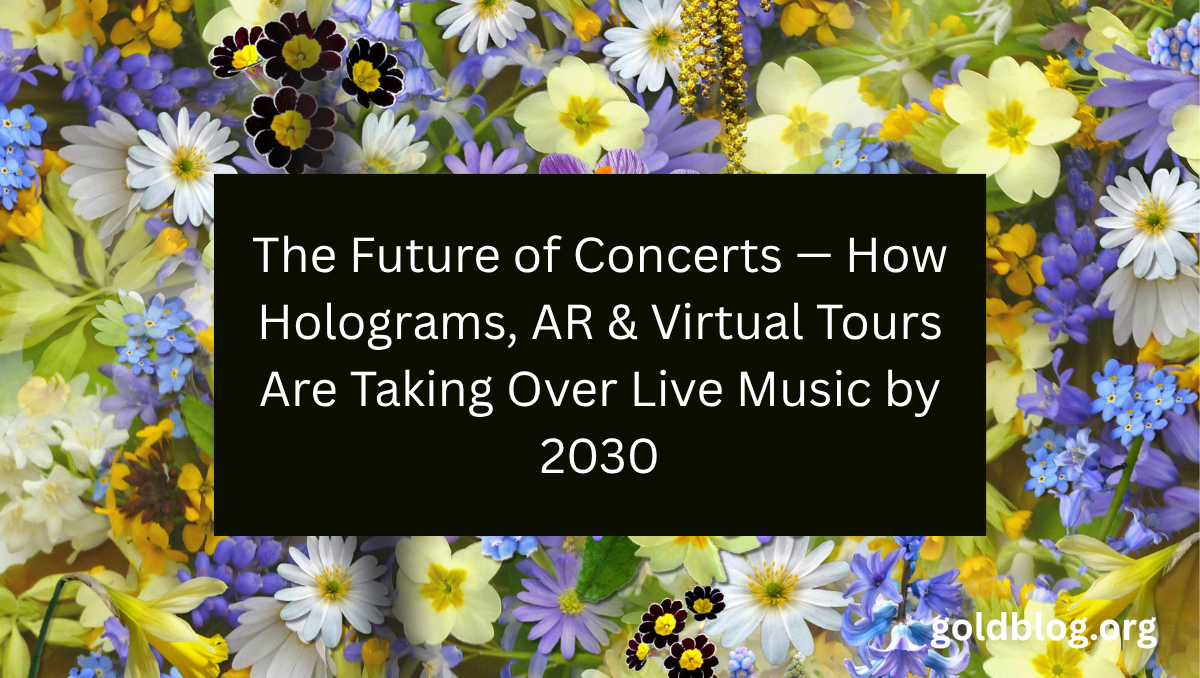Meta Title: The Future of Concerts 2030 — How Holograms and AR Are Redefining Live Music in America
Meta Description: By 2030, holographic and virtual concerts dominate U.S. entertainment. Here’s how technology is reshaping how Americans experience live music.
🚀 Introduction
In 2025, live concerts made a huge comeback after the pandemic-era lull.
By 2030, they’ve evolved into something completely new — part performance, part simulation, part digital miracle.
Thanks to advances in augmented reality (AR), holography, AI avatars, and mixed-reality arenas, the American concert industry has become a billion-dollar hybrid ecosystem — blending the physical and the virtual.
You don’t just go to concerts anymore. You enter them.
🎶 1. From Stages to Simulations — The New Concert Experience
By 2030, the U.S. concert landscape looks vastly different from 2020s tours.
Physical shows haven’t disappeared — they’ve multiplied through technology-assisted replication.
🔹 The Three Types of Concerts Now Common in 2030:
- Holographic Performances: AI-generated visual clones of artists projected in 4K realism — performing simultaneously in multiple cities.
- AR Stadium Shows: Fans use smart glasses or phone AR apps to see digital effects layered onto live shows — dragons flying, lyrics floating, 3D visuals reacting to beats.
- Virtual Reality Tours: Fully immersive VR concerts streamed worldwide, where fans attend via avatars — no travel needed.
“By 2030, an artist can perform in New York, while millions experience it in Dallas, Tokyo, or VR — all in real time.”
— Billboard Live Tech Report, 2030
💡 2. The Rise of Hologram Artists
What started with Tupac’s Coachella hologram in 2012 has now become standard entertainment.
In 2030, companies like Holobeat, StageVerse, and MetaLive produce high-fidelity holograms capable of:
- Realistic facial movements and lighting reflection
- AI-generated speech and crowd interaction
- Perfect synchronization with live band or backup dancers
🔹 The Hologram Hall of Fame (2030):
- Elvis Presley Live Forever Tour — grossed $300M across 20 cities.
- Freddie Mercury 2030 Tribute — reimagined performance using his real vocal stems.
- Taylor Swift: EverMoreverse Experience — dual hologram shows in Los Angeles & London, streamed in mixed reality.
These shows blur the line between nostalgia and innovation — offering new live experiences with old legends.
🧠 3. Augmented Reality Concerts — Music Meets Magic
AR has turned traditional concerts into cinematic events.
Using Apple Vision Pro, Meta Glass, or Samsung Spectra lenses, U.S. concertgoers in 2030 can see:
- Floating 3D lyrics synced to songs
- Virtual dancers joining the real stage
- Story-driven visual effects reacting to tempo and audience energy
- Personalized setlists projected in the air near your seat
AR also enables “choose-your-view” features — letting you switch between stage, backstage, or drone perspectives mid-song.
Example:
Billie Eilish’s 2030 “Innerworld” Tour combined AR butterflies, water illusions, and 360° crowd visuals — creating an emotionally immersive experience described as “music felt in 4D.”
💰 4. The Virtual Concert Economy
Virtual and hybrid concerts have become America’s fastest-growing entertainment segment, valued at $35 billion in 2030 (Statista).
Revenue streams include:
- Virtual ticket tiers ($15–$200)
- Digital merch (NFTs & AR wearables)
- Brand sponsorships inside VR environments
- AI-generated meet-and-greets — where fans chat with artist avatars in real time
Example:
Travis Scott’s 2020 Fortnite concert drew 12M viewers.
In 2030, similar experiences are now monthly events — across platforms like Roblox Verse, Apple Music XR, and Spotify Worlds.
🎤 5. Real Artists Go Digital — The Clone Tours
Even active musicians are embracing AI replicas to extend touring capacity.
In 2029, Beyoncé and Bad Bunny became the first artists to license official digital doubles for simultaneous global tours.
These AI avatars perform perfectly synced shows using real-time motion data from the artist’s physical concert — allowing one night to become ten concerts at once.
“It’s not replacing me. It’s multiplying me.”
— Beyoncé, Variety Interview, 2029.
This hybrid touring model reduces travel strain, boosts sustainability, and expands access — a win-win for artists and fans alike.
⚙️ 6. Technology Behind the Magic
The concert experience in 2030 is powered by AI, cloud computing, and volumetric capture.
🔹 Core Innovations:
- HoloStage XR: AI-driven hologram projection with 0.02s latency.
- MetaVenue Cloud: Streams synchronized shows globally at 120 FPS.
- AR Pulse Sensors: Convert audience energy (cheers, heart rate) into reactive visuals.
- Quantum Audio Sync: Delivers real-time sound mixing across continents.
In short: the physics of live entertainment have been rewritten.
📈 7. The New Concert Demographics
By 2030, U.S. audiences are more digitally connected than ever:
- Gen Z & Alpha: 72% attend virtual or AR concerts regularly.
- Millennials: 58% prefer hybrid events (physical + virtual).
- Boomers: 33% engage via nostalgic hologram tours.
Accessibility has expanded too — fans who couldn’t afford live tickets now experience premium-quality VR concerts from home, complete with crowd audio and live chat interaction.
Music is now borderless and classless.
⚖️ 8. The Ethical and Emotional Debate
Despite the innovation, not everyone is cheering.
Critics argue that hologram shows commercialize legacies of deceased artists without proper emotional context.
There’s also concern over deepfake misuse — unauthorized holograms performing unreleased songs.
As a result, the U.S. passed the Digital Performance Rights Act (2028) — requiring consent from estates or living artists before replication.
Still, most fans view the evolution positively, seeing it as preservation through experience, not exploitation.
🧠 Conclusion
By 2030, concerts are no longer bound by geography, mortality, or even physics.
They’re immersive worlds — fusing sound, emotion, and technology into one shared universe.
Holograms bring the past to life.
AR blurs imagination with presence.
And virtual tours make every seat in the house the best one.
The stage hasn’t disappeared — it’s multiplied.
And for the next generation of American fans, the show never really ends.
